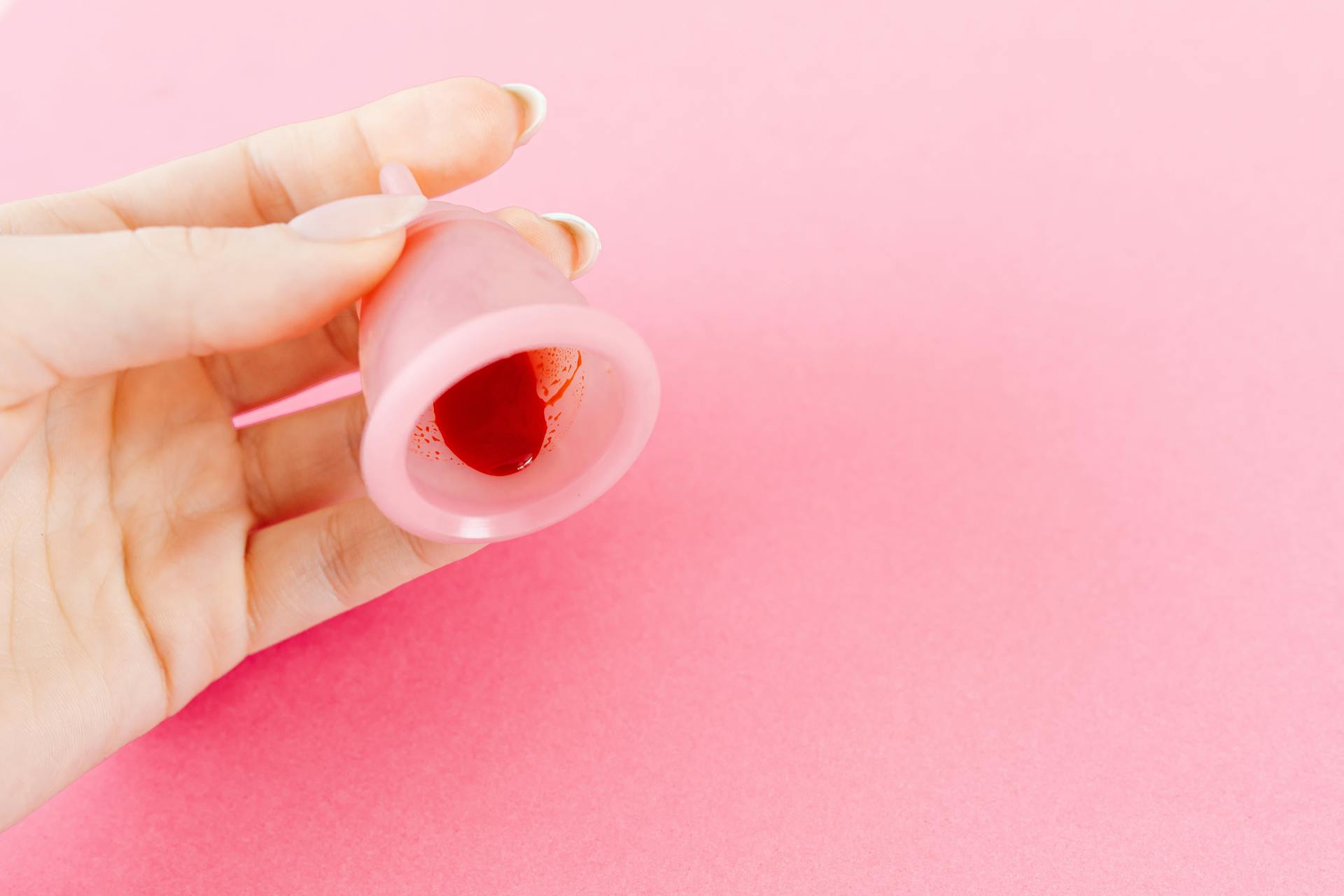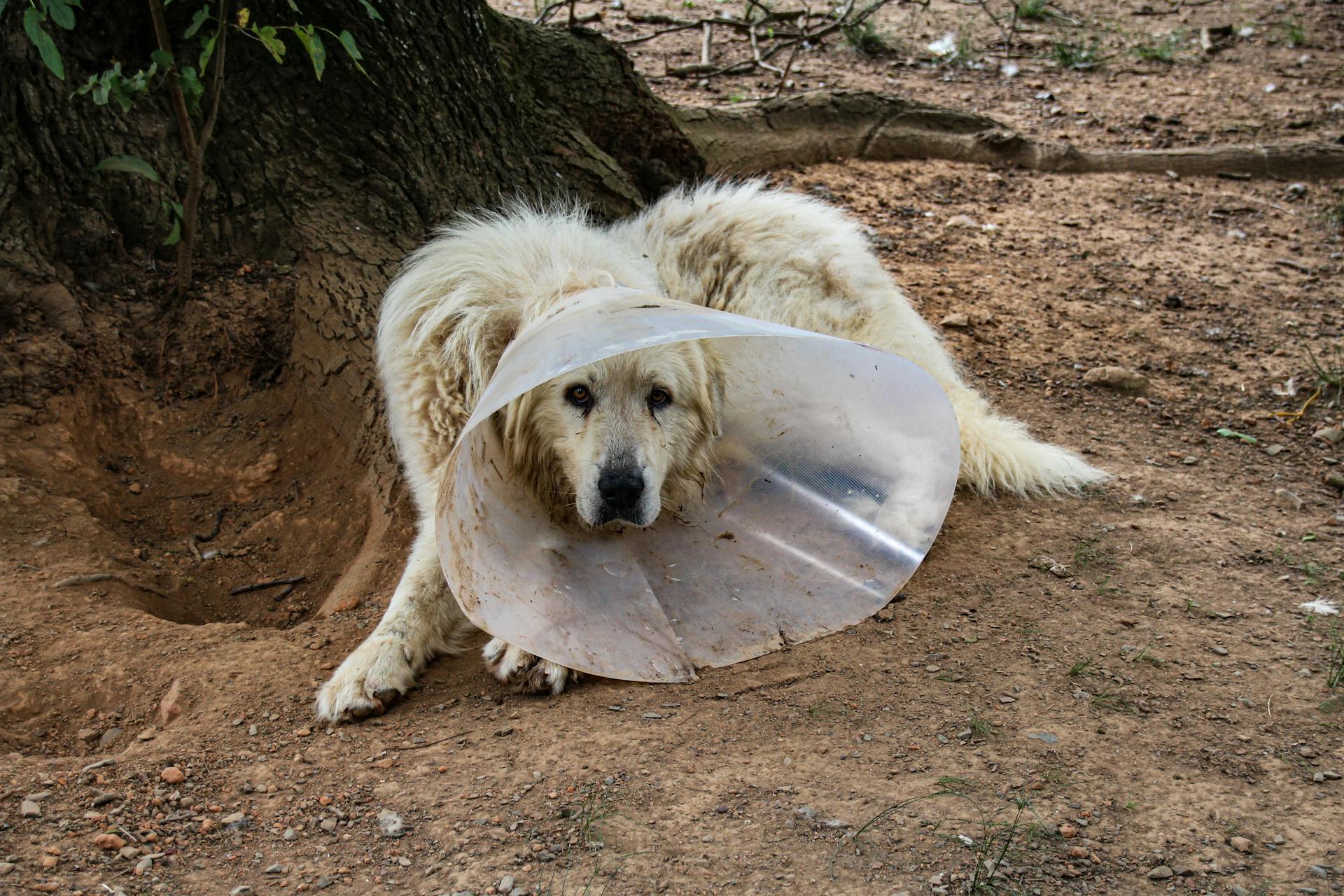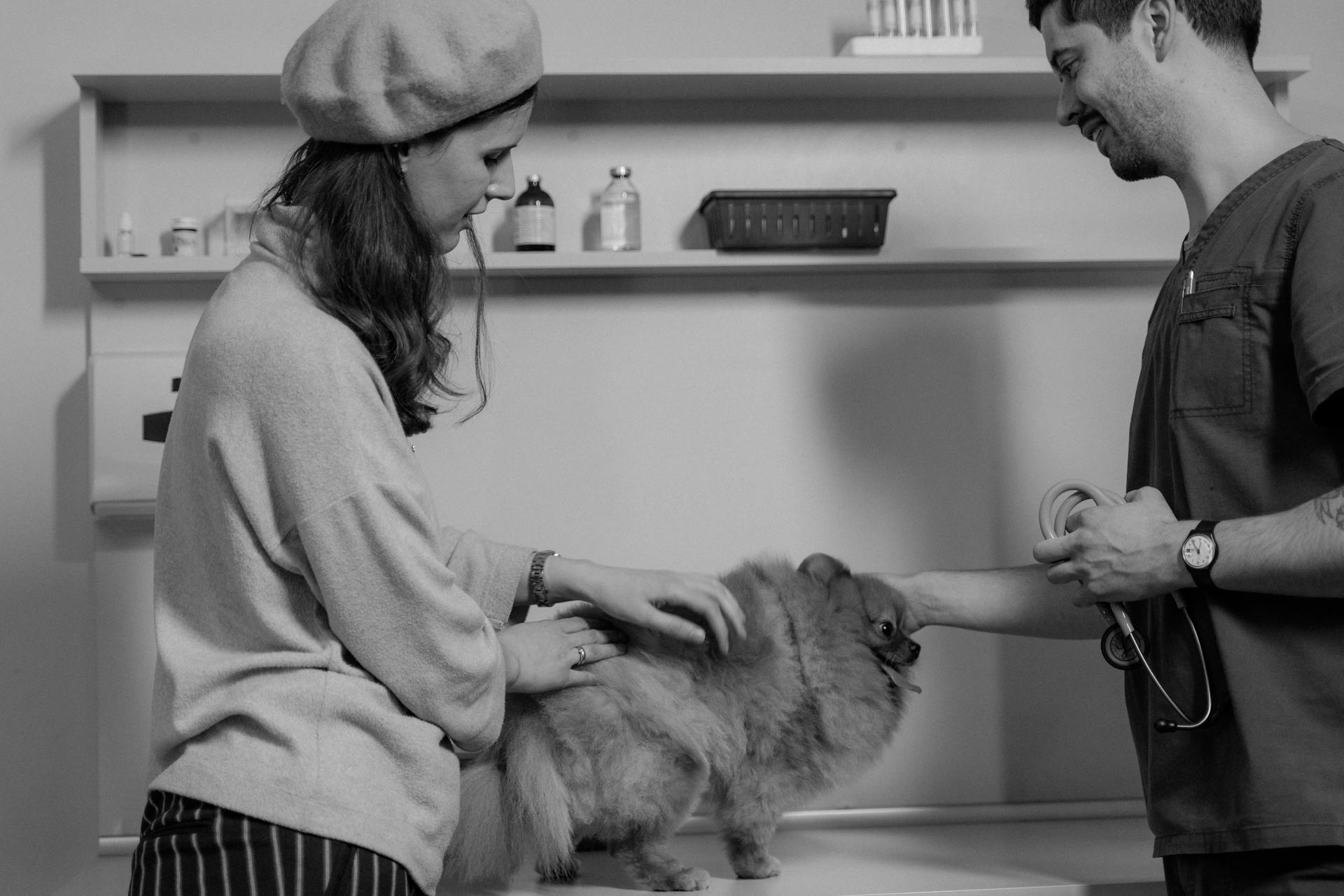
Female dogs can experience a range of discharge symptoms, from a clear, watery liquid to a thick, bloody discharge. It's essential to understand what's normal and what's not.
A clear or cloudy discharge is usually a sign of a healthy reproductive system, but it can also indicate a mild infection. This type of discharge is often accompanied by a slight odor.
If your dog is experiencing a thick, bloody discharge, it could be a sign of a more serious infection or even a medical condition such as pyometra. This is a life-threatening condition that requires immediate veterinary attention.
A normal discharge in a healthy female dog is usually clear or slightly cloudy, and it's a good idea to keep an eye on your dog's discharge to ensure it's not a sign of an underlying issue.
For more insights, see: Female Dog Green Discharge
Causes and Diagnosis
Causes of vaginal discharge in dogs can be quite varied. Both intact and spayed female dogs can experience abnormal vaginal discharge, but certain causes are more common in intact dogs.
Check this out: Female Dog Vaginal
Abnormal vaginal discharge can be caused by a number of factors, including hormonal changes, infections, and physical injuries.
Progesterone-based drugs can cause changes in the uterus similar to the estrus cycle, and estrogen or synthetic estrogen drugs can increase the effects of progesterone on the uterus.
In fact, drugs containing both estrogen and progesterone are sometimes used to treat certain conditions of the reproductive system, but they must be carefully monitored to prevent the development of pyometra.
To diagnose the underlying cause of vaginal discharge, your veterinarian will likely perform a thorough physical exam and take a complete medical history of your dog.
They may also take a sample of the discharge to examine under a microscope and culture it if they suspect an infection.
Some common diagnostic tests for pyometra include a general chemistry profile, complete blood count, urinalysis, abdominal radiographs, abdominal ultrasound, and vaginal cytology.
Here are the diagnostic tests your veterinarian may recommend to diagnose pyometra:
- General chemistry profile
- Complete blood count
- Urinalysis
- Abdominal radiographs
- Abdominal ultrasound
- Vaginal cytology
Dogs: Symptoms and Behaviors
If your female dog is experiencing a discharge, it's essential to recognize the symptoms and behaviors that may indicate a serious health issue. Lethargy and depression are common signs of pyometra in dogs.
Dogs with pyometra may also exhibit excessive water intake and urination, which can be a sign that the infection is causing toxins to be released into the circulation.
Pale mucous membranes and a bloody vaginal discharge are also typical symptoms of pyometra. Some dogs may not show any clinical signs other than a vaginal discharge containing pus.
Here are the common symptoms of pyometra in dogs:
- Lethargy
- Depression
- Anorexia
- Excessive water intake
- Excessive urination
- Pale mucous membranes
- Bloody vaginal discharge
In severe cases, dogs with closed pyometra may become anorectic, listless, and depressed, and may even experience vomiting or diarrhea.
Treatment and Care
Most cases of vaginal discharge will recover well with proper treatment. If your dog has pyometra, the best course of action is to spay her, as this procedure removes the uterus and therefore the infection.
Proper hygiene is also essential in keeping abnormal vaginal discharge at bay. Keeping your dog clean and in a clean environment can help prevent the issue.
If your dog has a big issue with cleanliness, consider trimming or shaving the hair around her genital area. You may also wash it with warm water or a mild soap if necessary.
Here are some pet-safe wet wipes that are effective on dirt and odors but also gentle on the skin: Hepper's Wash Wipes These USA-made premium wipes are safe for dogs of any age and contain hypoallergenic, moisturizing ingredients.
Treatment for Dogs
Treatment for dogs with vaginal discharge can be successful with proper care. Most cases will recover well with treatment.
For dogs with pyometra, the best course of treatment is spaying, which removes the uterus and infection. Keeping your dog clean and in a clean environment can also help prevent abnormal vaginal discharge.
Readers also liked: Dog Eye Discharge after Boarding
Spaying is the preferred treatment for pyometra, and most dogs are good surgical candidates if diagnosed early. Surgery is usually complicated and requires intravenous fluids and antibiotics post-operatively.
There is a medical approach to treating pyometra using prostaglandins, but it's not always successful and has limitations. Prostaglandins can cause side effects like restlessness, panting, and vomiting, and may not show clinical improvement for 48 hours.
Here are some key things to consider when treating pyometra:
- Side effects from prostaglandin treatment can be severe and may include abdominal pain, defecation, salivation, and vomiting.
- The risk of uterine rupture and peritonitis is high when using prostaglandins, especially if the cervix is closed.
- The success rate of prostaglandin treatment is variable, and recurrence of the disease is possible.
Veterinary Emergency
A pyometra is a uterine infection and it's a true veterinary emergency.
A middle-aged, intact female dog can be at risk of developing a pyometra, especially if she's showing signs of depression and lethargy.
A veterinarian like Dr. Gary Brummet will likely be concerned about a potential pyometra if a dog's owner reports these symptoms.
A pyometra requires immediate attention from a veterinarian, making it a veterinary emergency that can't wait.
A delay in treatment can lead to serious consequences, so it's essential to seek veterinary care right away if you suspect your dog may have a pyometra.
Check this out: Dog Names Female Start with S
Treatment Costs

Treating pyometra in dogs can be costly, but understanding the factors that affect the total cost can help you prepare financially. The total cost can range from $1,000 to $10,000, depending on several factors.
Early diagnosis is crucial, as it can significantly impact the overall cost. If the disease is caught early, the treatment costs may be lower.
Surgical treatment, such as spaying, is a common approach to treating pyometra. The cost of surgery can range from $500 to $4,000.
Hospital stays are also a significant expense, with costs ranging from $200 to $2,000 per day. This can add up quickly, especially if your dog requires extended care.
Diagnostic tests, including blood tests and ultrasound, can cost anywhere from $200 to $3,000. These tests are essential in determining the best course of treatment.
Medications, such as antibiotics and pain relief, can cost between $50 to $400. Follow-up care, including check-ups and medication refills, can cost an additional $50 to $350.
Here's a breakdown of the estimated costs associated with treating pyometra in dogs:
Discharge Types and Stages
Normal vaginal discharge in dogs is typically clear and in small amounts, but excessive discharge can indicate an issue. This fluid is produced due to the vagina's self-cleaning mechanism to flush out bacteria and other irritants.
Yellow or white discharge may indicate an infection, as the presence of white blood cells gives it that color. Red, pink, or brown discharge may be due to the presence of blood.
The clinical signs of pyometra depend on whether the cervix remains open. If it is open, purulent discharge will drain from the uterus through the vagina to the outside.
Additional reading: Female Dog Smelly Discharge
What Are the Stages of?
Pyometra in dogs is a serious condition that requires attention. Like any disease, there are several stages to pyometra in dogs, notes Glassman.
The stages of pyometra in dogs are not well-defined, but they can be broadly classified into several categories. Each stage has its own set of symptoms and complications.
Additional reading: Female Dog Pregnancy Stages

In one stage, the cervix is blocked, preventing the discharge of the accumulated pus. This can lead to severe abdominal pain and vomiting.
The accumulation of pus in the uterus can also cause the cervix to become swollen and inflamed, leading to discharge in another stage. Discharge can be a sign of pyometra in dogs.
Early Stage
The early stage of vaginal discharge in dogs is a crucial time to catch any potential issues before they become severe. Hormonal changes after a heat cycle can lead to an increase in the uterus lining, creating an environment conducive to bacterial growth.
This can sometimes be preceded by endometrial hyperplasia, where the lining of the uterus becomes thickened and remains that way, creating a perfect breeding ground for bacteria.
If left unchecked, this can lead to pyometra, a serious condition where the uterus fills with pus and can cause severe illness and even death.

The early stage of pyometra is often characterized by a dog's menstrual cycle getting stuck in a phase where the uterus lining becomes thickened and remains that way, creating an environment conducive to bacterial growth.
In some instances, the cervix remains open, allowing purulent discharge to drain from the uterus through the vagina to the outside, which may be observed on the skin or hair under the tail or on bedding and furniture.
But if the cervix is closed, the discharge collects in the uterus, causing distention of the abdomen, and the bacteria release toxins that are absorbed into the circulation, leading to severe illness.
Frequently Asked Questions
What does it mean when a female dog leaks clear fluid?
Clear fluid leakage in female dogs may indicate an underlying vaginal or urinary tract issue, such as an infection or foreign body. If you suspect your dog is experiencing this symptom, consult a veterinarian for proper diagnosis and treatment
What does pyometra discharge look like?
Pyometra discharge is typically white, yellowish, or green in color. If you notice any unusual vaginal discharge in your female dog, it's essential to seek veterinary attention immediately.
Do female dogs have discharge before period?
Yes, female dogs often experience bloody vaginal discharge before coming into heat, which is usually the first noticeable sign. This discharge can be a subtle indication that your dog is approaching her heat cycle.
Do dogs have white discharge after period?
White discharge in dogs can be a sign of infection or other health issues, not necessarily related to their menstrual cycle. If you're concerned about your dog's genital discharge, it's best to consult a veterinarian for proper diagnosis and care
How to treat clear jelly discharge from female dog?
Clear jelly discharge in female dogs may require antibiotics and possible surgery to drain and clean the infection site. Consult a veterinarian for proper diagnosis and treatment
Sources
- https://www.dogster.com/lifestyle/vaginal-discharge-in-dogs
- https://vcahospitals.com/know-your-pet/pyometra-in-dogs
- https://vetmed.illinois.edu/pet-health-columns/pyometra-infection-dogs-uterus/
- https://www.forbes.com/advisor/pet-insurance/pet-care/pyometra-in-dogs/
- https://metro-vet.com/references/pyometra/
Featured Images: pexels.com


